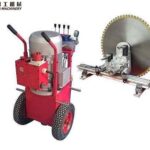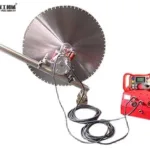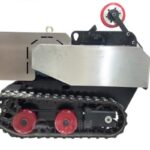Wall saw cutting machine, also known as a track saw or concrete wall saw, is a specialized tool designed to cut vertical or horizontal surfaces such as walls and slabs. It typically consists of a circular blade mounted on a track system, allowing smooth, accurate movement along the cutting path. This track ensures perfectly straight, vertical, or horizontal cuts. Engineered for heavy-duty construction and demolition projects, its blade is designed for cutting concrete, brick, stone, and other tough materials.
Components of the Wall Saw Cutting Machine
- Power Unit: Hydraulic (high power, run by separate power pack) or Electric (common, plug-and-play).
- Cutting Head: Houses the diamond blade, drive motor, and feed mechanism.
- Track System: Rails that guide the cutting head with precision. Secured via anchors or vacuum plates.
- Diamond Blade: Segmented or continuous rim blades specifically designed for deep concrete/masonry cutting. Size (diameter) dictates maximum cutting depth.
Applications of Concrete Wall Cutting Machines
- Creating Openings: Wall saw cutting machine is applied for doorways, windows, elevator shafts, HVAC ducts in concrete walls/floors.
- Controlled Demolition: Sectional removal of concrete elements (walls, balconies, beams).
- Structural Modifications: Preparing for additions, retrofitting, and seismic upgrades.
- Concrete Removal: Cutting around embedded elements (rebar, pipes) or removing damaged sections.
- Precision Cutting: For utility trenches, plumbing/electrical chases, or intricate shapes.
- Slab Separation: Cutting expansion joints or separating slabs.
Benefits of Using a Concrete Wall Saw
Precision: Achieves clean, straight cuts with minimal spalling.
Efficiency: Completes projects faster than traditional methods.
Versatility: Works on vertical, horizontal, and overhead surfaces.
Cost-Effective: Minimizes waste and repair costs.
Considerations for Choosing the Right Wall Saw Machine
- Cutting Depth and Blade Diameter: Choose a suitable wall saw cutting machine based on your maximum cutting requirement.
- Power Source: Hydraulic for heavy-duty work; high-frequency for general use.
- Track Length: Longer tracks enable longer cuts without repositioning.
- Cooling System: Wet cutting systems reduce dust and keep the blade from overheating.
- Portability: Lightweight and modular designs are easier to transport and set up.
- Control Interface: Look for models with intuitive, ergonomic controls or remote capabilities.




